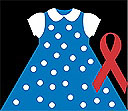 | ||
|
| ||
|
Special thanks to The Clinton Foundation, CARE, Sheila Johnson, President George H. W. Bush's Points of Light Foundation and many others for their inspiration in establishing Veronica's Story Foundation. | ||
| ||
| ||
| ||
| ||
| ||
| ||
| ||
| ||
| ||
| ||
| ||
| ||
| ||
| ||
| ||
| ||
| ||
| ||
| ||
| ||
| ||
| ||
|
| ||
|
Veronica's Story Foundation 1490-5A Quarterpath Rd #185 Williamsburg, VA 23185 757-243-3025 Send Us  E-mail
E-mail
© Copyright 2007 VeronicasStory.org All Rights Reserved |
| REALITY CHECK |
AIDS
AIDS is now second only to the Black Death as the largest epidemic in history. AIDS kills about 2.9 million people a year, or about one person every 11 seconds. This death toll includes a lot of children, who are often infected with the HIV virus during pregnancy or through breast-feeding.
The toll is worst in Africa, where millions of parents have died, leaving children as orphans. Often teachers have died as well, leaving schools empty. Doctors and nurses have died, leaving hospitals and medical clinics with nothing. Farmers have died, leaving crops in the fields. Entire villages have been devastated.
Yet AIDS is a preventable and increasingly treatable disease. The huge majority of deaths can be stopped. Through education, the use of condoms, and proper medicine, AIDS has been brought under control in the developed countries. The same can be true in Africa and other poor areas of the world.
Sources: Joint United Nations Program on HIV/AIDS (UNAIDS), World Health Organization (WHO).
MALARIA
Over a million people die from malaria each year and many millions more are seriously weakened by it. Malaria is spread by mosquitoes. One bite from an infected mosquito can mean weeks of fever and exhaustion, preventing children from going to school and adults from working to provide for their families. Close to 90% of malaria cases occur in Africa.
Although malaria is treatable with anti-malarial drugs, these are often not available in the poorest areas. The best cure is prevention, and the best prevention is mosquito nets for beds. This bed netting protects people from mosquitoes while they sleep at night, when the mosquitoes come out.
The cost for a bed net is $6, but since people in Africa often sleep two or more to a bed, the cost per person is about $3. Ideally, every person in the affected areas of Africa would be provided with a bed net. Besides saving lives, this would be an excellent economic investment, as the cost of malaria to Africans in lost productivity alone is estimated in the billions of dollars each year.
Sources: UNICEF, World Health Organization (WHO).
TUBERCULOSIS
In the entire history of humankind, it is believed that tuberculosis has killed more people than any other disease (in shorter periods of time, the epidemics of the Black Death and AIDS have killed more). Tuberculosis dates back to at least 4000 BC and was present in ancient Egypt, Greece, Rome, and India. Known as consumption, it was responsible for one in five deaths in 17th century London.
Tuberculosis is highly contagious and spreads through the air from coughing. If not treated, a person with TB infects an average of 10 to 15 new people each year. Once thought to be under control, tuberculosis still kills well over 1.5 million people each year, a figure that is now increasing slightly each year.
In 1995 the World Health Organization launched a multi-pronged tuberculosis program called DOTS (Directly Observed Therapy). Since then it has successfully treated more than 22 million tuberculosis patients. Funding is needed so that this effective program can expand to reach all the people who need it.
Sources: World Health Organization (WHO), Stop TB Partnership


Community Water Pit In Rural Ethiopia

Mothers and Children Collect Dirty Water To Drink